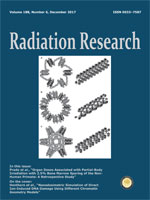Radiation nephropathy is one of the common late effects in cancer survivors who received radiotherapy as well as in victims of radiation accidents. The clinical manifestations of radiation nephropathy occur months after exposure. To date, there are no known early biomarkers to predict the future development of radiation nephropathy. This study focuses on the development of urinary biomarkers providing readout of acute responses in renal tubular epithelial cells. An amplification-free hybridization-based nCounter assay was used to detect changes in mouse urinary miRNAs after irradiation. After a single LD50 of total-body irradiation (TBI) or clinically relevant fractionated doses (2 Gy twice daily for 3 days), changes in urinary levels of microRNAs followed either an early pattern, peaking at 6–8 h postirradiation and gradually declining, or later pattern, peaking from 24 h to 7 days. Of 600 miRNAs compared, 12 urinary miRNAs showed the acute response and seven showed the late response, common to both irradiation protocols. miR-1224 and miR-21 were of particular interest, since they were the most robust acute and late responders, respectively. The early responding miR-1224 also exhibited good dose response after 2, 4, 6 and 8 Gy TBI, indicating its potential use as a biomarker for radiation exposure. In situ hybridization of irradiated mouse kidney sections and cultured mouse primary renal tubular cells confirmed the tubular origin of miR-1224. A significant upregulation in hsa-miR-1224-3p expression was also observed in human proximal renal tubular cells after irradiation. Consistent with mouse urine data, a similar expression pattern of hsa-miR-1224-3p and hsa-miR-21 were observed in urine samples collected from human leukemia patients preconditioned with TBI. This proof-of-concept study shows the potential translational utility of urinary miRNA biomarkers for radiation damage in renal tubules with possible prediction of late effects.
How to translate text using browser tools
4 October 2017
Urinary miRNAs as Biomarkers for Noninvasive Evaluation of Radiation-Induced Renal Tubular Injury
Sagar Bhayana,
Feifei Song,
Jidhin Jacob,
Paolo Fadda,
Nicholas C. Denko,
Meng Xu-Welliver,
Arnab Chakravarti,
Naduparambil K. Jacob
ACCESS THE FULL ARTICLE

Radiation Research
Vol. 188 • No. 6
December 2017
Vol. 188 • No. 6
December 2017




